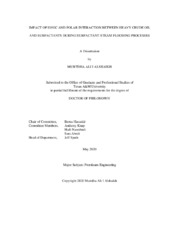| dc.description.abstract | Surfactant injection as additives to steam injection is a concept that has great potential to enhance oil recovery efficiency of heavy oil and bitumen. Steam injection enhances oil recovery by introducing heat to the reservoir, decreasing oil viscosity, reducing residual oil, and distillation process of light oil fractions. Although steam has been successfully applied to enhance oil recovery, it has many challenges including heat losses, steam gravity override and channeling which decrease the oil recovery efficiency and can raise the cost above the economic limit. Steam injection is, also, harmful to the environment due to greenhouse gases (GHG) emission, water pollution, and contamination of groundwater aquifers. To overcome these challenges, surfactants have been suggested to be co-injected with steam to enhance microscopic displacement, reduce steam usage, and increase oil recovery. The microscopic oil recovery enhancement comes from the different electrostatic interactions during surfactant-steam process. Surfactant literature is in general built on light/medium oil reservoirs, which are form mostly by nonpolar hydrocarbon. For high-viscosity crudes, the situation can be different due to the high-polarity components of crude oil. Asphaltene and resins are known as polar components of crude oils, while saturates and aromatics are nonpolar. It is not very well-known how surfactants interact with those crude oil components in the presence of steam. Importantly, the mutual interactions between crude oil components, water, and surfactant examination are essential to determine the surfactant candidate for steam-surfactant flood. The focus of this research is to study the microscopic interactions during enhance oil recovery process of surfactant-steam flooding and investigate the role of polar-polar interaction and ionic interaction. Based on core-flood experimental results, the addition of surfactants improves the oil recovery of steam injection. The analyses suggest that polarity magnitude of crude oil is controlled by the mutual interaction of its polar fractions via dipole-dipole interaction and not by their quantities. The mutual interaction of crude oil fractions with surfactants in the presence of steam was visualized by optical microscopy and showed the negative impact of asphaltenes as emulsion inhibitor. During surfactant-steam flood, it appears that the surfactants interacted with the asphaltenes fractions via ion-ion or/and ion-dipole interactions, enhancing asphaltenes stability which is evident by its high content in the recovered oil of core-flood experiments and the high absolute values of the asphaltenes’ zeta potential. Finally, the resulted addition of nonionic surfactants makes the separation of water-in-oil emulsion processes easier. In addition to this advantage, the economic analysis revealed that the nonionic surfactants are the most economical to use as steam additives. | en |


